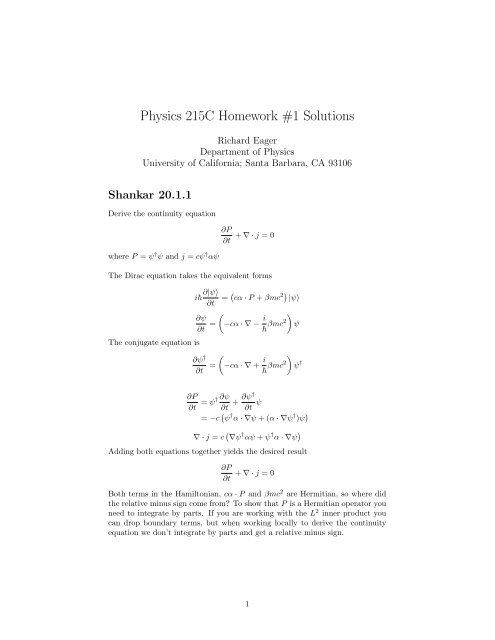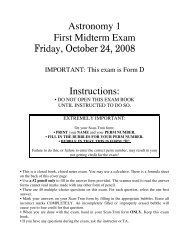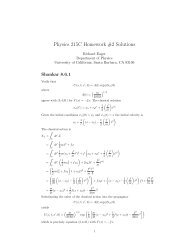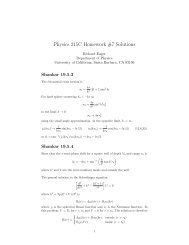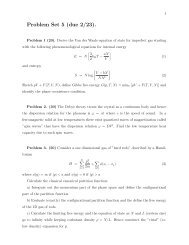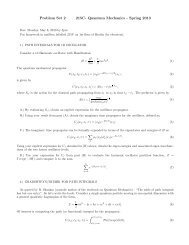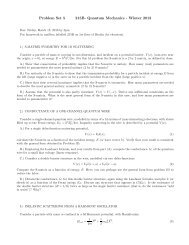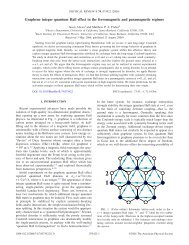Physics 215C Homework #1 Solutions - KITP - University of ...
Physics 215C Homework #1 Solutions - KITP - University of ...
Physics 215C Homework #1 Solutions - KITP - University of ...
You also want an ePaper? Increase the reach of your titles
YUMPU automatically turns print PDFs into web optimized ePapers that Google loves.
<strong>Physics</strong> <strong>215C</strong> <strong>Homework</strong> <strong>#1</strong> <strong>Solutions</strong><br />
Richard Eager<br />
Department <strong>of</strong> <strong>Physics</strong><br />
<strong>University</strong> <strong>of</strong> California; Santa Barbara, CA 93106<br />
Shankar 20.1.1<br />
Derive the continuity equation<br />
where P = ψ † ψ and j = cψ † αψ<br />
∂P<br />
∂t + ∇ · j = 0<br />
The Dirac equation takes the equivalent forms<br />
The conjugate equation is<br />
i ∂|ψ〉<br />
∂t<br />
= ( cα · P + βmc 2) |ψ〉<br />
(<br />
∂ψ<br />
∂t = −cα · ∇ − i )<br />
βmc2 ψ<br />
∂ψ †<br />
∂t<br />
=<br />
(−cα · ∇ + i βmc2 )<br />
ψ †<br />
∂P<br />
∂t<br />
∂ψ<br />
= ψ†<br />
∂t + ∂ψ†<br />
∂t ψ<br />
= −c ( ψ † α · ∇ψ + (α · ∇ψ † )ψ )<br />
∇ · j = c ( ∇ψ † αψ + ψ † α · ∇ψ )<br />
Adding both equations together yields the desired result<br />
∂P<br />
∂t + ∇ · j = 0<br />
Both terms in the Hamiltonian, cα · P and βmc 2 are Hermitian, so where did<br />
the relative minus sign come from? To show that P is a Hermitian operator you<br />
need to integrate by parts. If you are working with the L 2 inner product you<br />
can drop boundary terms, but when working locally to derive the continuity<br />
equation we don’t integrate by parts and get a relative minus sign.<br />
1
2<br />
Show that the probability current j <strong>of</strong> the previous exercise reduces in the nonrelativistic<br />
limit to Eq.(5.3.8) [which is the same as Sakurai Eq.(2.4.16)].<br />
( ) 0 σ<br />
The probability current j = cψ † αψ and α = We can write the wave<br />
(<br />
σ 0<br />
χ<br />
function ψ = in terms <strong>of</strong> its relativistic and non-relativistic components,<br />
Φ)<br />
Φ and χ respectively.<br />
In the non-relativistic limit (20.2.13)<br />
j = c ( ( ( )<br />
χ † Φ †) 0 σ χ<br />
σ 0)<br />
Φ<br />
(0.1)<br />
= c ( χ † σΦ + Φ † σχ ) (0.2)<br />
Φ ≈ σ · π<br />
2mc<br />
j = χ † ˆp<br />
2m χ + ( ˆp<br />
2m χ† )χ<br />
which is the non-relativistic current (5.3.8)<br />
j =<br />
from the identification ˆp = −i∇.<br />
Shankar 20.2.1<br />
<br />
2mi (ψ∗ ∇ψ − ψ∇ψ ∗ )<br />
Show that<br />
where π = P − qA c .<br />
π × π = iq<br />
c B<br />
π × π = P × P − qA c × P − P × qA c + qA c × qA c<br />
= − q (A × P + P × A)<br />
c<br />
= iq<br />
c<br />
(A × ∇ + ∇ × A)<br />
The simplest way to manipulate operators is to act on a test function ψ<br />
Therefore<br />
iq<br />
c<br />
iq<br />
(A × ∇ + ∇ × A) ψ = (A × ∇ψ + ∇ × (ψA))<br />
c<br />
= iq<br />
c<br />
= iq<br />
c<br />
= iq<br />
c Bψ<br />
(A × ∇ψ + (∇ψ)A + (∇ × A)ψ)<br />
(∇ × A) ψ<br />
π × π = iq<br />
c B<br />
2
Shankar 20.1.1<br />
Solve for the 4 spinors w that satisfy Shankar Eq. 20.3.3. You may assume that<br />
the 3- momentum ⃗p is along the z-axis. Normalize them to unity, and show that<br />
they are mutually orthogonal.<br />
Equation (20.3.3) is<br />
Ew = (α · p + βm)w<br />
In terms <strong>of</strong> the relativistic and non-relativistic components,<br />
( ( ) (<br />
E − m −σ · p χ 0<br />
=<br />
−σ · p E + m)<br />
Φ 0)<br />
The ( solutions ( are given in equations (20.3.7) and (20.3.8). Choosing the basis<br />
1 0<br />
and for Φ and letting p be in the z direction,<br />
0)<br />
1)<br />
w 1,3 =<br />
⎛<br />
⎞<br />
p/(±E − m)<br />
⎜<br />
⎝<br />
0<br />
1<br />
0<br />
⎟<br />
⎠ w 2,4 =<br />
⎛<br />
⎞<br />
0<br />
p/(±E − m)<br />
⎜<br />
⎟<br />
⎝ 0 ⎠<br />
1<br />
Orthogonality <strong>of</strong> the spinors is easy to see using E 2 = p 2 + m 2 .<br />
5<br />
The five terms in 20.2.28 are<br />
P 2<br />
2m<br />
V<br />
− P 4<br />
8m 3 c 2<br />
iσ · P × [P, V ]<br />
4m 2 c 2<br />
P · [P, V ]<br />
4m 2 c 2<br />
Hermitian<br />
Hermitian<br />
Hermitian<br />
Hermitian<br />
anti-Hermitian<br />
Recall that ˆP is a Hermitian operator, the potential V is assumed to be<br />
Hermitian (for conservation <strong>of</strong> probability) and the Pauli matrices σ are Hermitian.<br />
The commutator [X, Y ] <strong>of</strong> two Hermitian operators is anti-Hermitian<br />
since [X, Y ] † = (XY ) † − (Y X) † = Y † X † − X † Y † = Y X − XY = −[X, Y ].<br />
The cross product <strong>of</strong> two Hermitian (vector) operators is again Hermitian since<br />
(X × Y ) † = X † × Y † = X × Y.<br />
3


